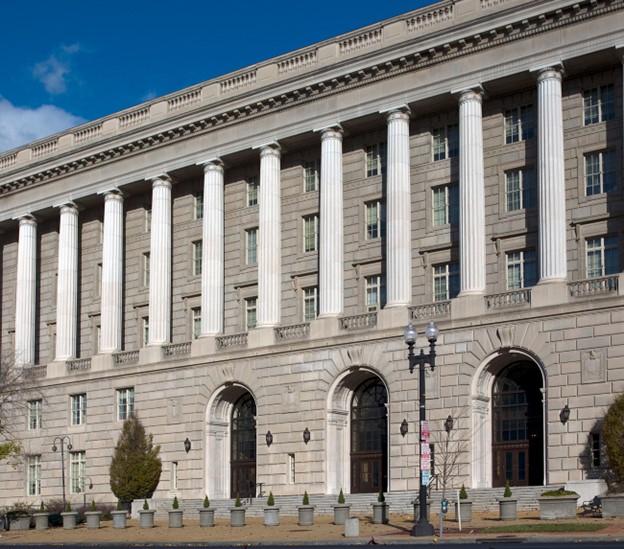In April, we discussed the 1984 Supreme Court decision in Chevron USA v. Natural Resource Def. Council, 467 US 837 (1984). “Briefly stated,” we wrote, “the case involved a challenge to regulations promulgated by the Environmental Protection Agency regarding air pollution controls mandated for manufacturing and oil refining plants and factories. In Chevron, the Court held that ‘[a]n agency, to engage in informed rulemaking, must consider varying interpretations and the wisdom of its policy on a continuing basis. Policy arguments…should be addressed to legislators or administrators, not to judges. The EPA’s interpretation of the statute here represents a reasonable accommodation of manifestly competing interests and is entitled to deference.’”
The Chevron case has been instrumental in the rise of the Administrative State. “For the past 40 years,” we noted, “this ‘Chevron deference’ has been granted to a variety of determinations made by every regulatory agency of the federal government. To paraphrase the substance of this deference, ‘they’re the experts – they know better.’”
We also described a pair of cases recently brought before the US Supreme Court that gave the high court the opportunity to revisit and perhaps reverse this deference to administrative agency determinations. “As described by Reuters, ‘[I]n Loper Bright Enterprises v. Raimondo…petitioners challenge[d] regulations of the National Marine Fisheries Service (NMFS) which impose a per diem fee on vessels to pay for the individual they are required to carry on trips to monitor compliance with fisheries rules under the Magnuson-Stevens Act (MSA).’ This case was consolidated with Relentless, Inc. v. Department of Commerce, ‘[also] a challenge to the per diem fees imposed by the NMFS on vessels to pay the cost of the observers the NMFS sends out to monitor the health of fisheries.’”
The Supreme Court’s decision has been published, and as most Conservatives and Free-Market proponents had hoped, the Chevron deference is no more.
Chief Justice Roberts’ majority opinion in Loper Bright Enterprises v. Raimondo explains the primary reason for the reversal of Chevron – the standard established in that case was a violation of statutory law which predates the Chevron decision itself.
In 1946, more than 35 years before Chevron was decided, Congress passed the Administrative Procedure Act (APA). A response to the Roosevelt “New Deal” era, Roberts writes that the APA was intended “’as a check upon administrators whose zeal might otherwise have carried them to excesses not contemplated in legislation creating their offices’…[i]t was the culmination of a ‘comprehensive rethinking of the place of administrative agencies in a regime of separate and divided powers.’” (Citations omitted.)
According to Chief Justice Roberts, “[i]n addition to prescribing procedures for agency action, the APA delineates the basic contours of judicial review of such action. As relevant here, Section 706 directs that ‘[t]o the extent necessary…the reviewing court shall decide all relevant questions of law, interpret constitutional and statutory provisions, and determine the meaning or applicability of the terms of an agency action’…It further requires courts to ‘hold unlawful and set aside agency action, findings, and conclusions found to be . . . not in accordance with law.’” (Citations omitted.)
Chief Justice Roberts describes the significance of this law; “The APA thus codifies for agency cases the unremarkable, yet elemental proposition…that courts decide legal questions by applying their own judgment. It specifies that courts, not agencies, will decide ‘all relevant questions of law’ arising on review of agency action…even those involving ambiguous laws…and set aside any such action inconsistent with the law as they interpret it. And it prescribes no deferential standard for courts to employ in answering those legal questions.”
“[B]y directing courts to ‘interpret constitutional and statutory provisions’ without differentiating between the two,” the Court writes, “Section 706 makes clear that agency interpretations of statutes – like agency interpretations of the Constitution – are not entitled to deference. Under the APA, it thus ‘remains the responsibility of the court to decide whether the law means what the agency says.’”
In essence, then, there never should have been a Chevron deference in the first place – “The deference that Chevron requires of courts reviewing agency action cannot be squared with the APA….Neither Chevron nor any subsequent decision of this Court attempted to reconcile its framework with the APA. The ‘law of deference’ that this Court has built on the foundation laid in Chevron has instead been ‘[h]eedless of the original design’ of the APA.” (Citations omitted.)
“Perhaps most fundamentally,” Roberts states, “Chevron’s presumption is misguided because agencies have no special competence in resolving statutory ambiguities. Courts do. The Framers, as noted, anticipated that courts would often confront statutory ambiguities and expected that courts would resolve them by exercising independent legal judgment. And even Chevron itself reaffirmed that ‘[t]he judiciary is the final authority on issues of statutory construction’…Chevron gravely erred, though, in concluding that the inquiry is fundamentally different just because an administrative interpretation is in play. The very point of the traditional tools of statutory construction – the tools courts use every day – is to resolve statutory ambiguities. That is no less true when the ambiguity is about the scope of an agency’s own power – perhaps the occasion on which abdication in favor of the agency is least appropriate.”
Judge John Wilson’s (ret.) article concludes tomorrow
